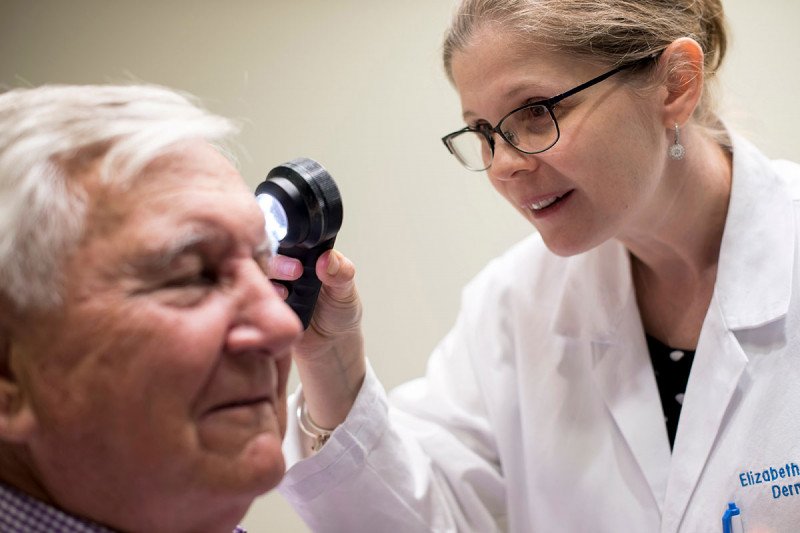
Dermatologist Elizabeth Quigley says anyone can be at risk for melanoma, the most dangerous form of skin cancer.
You know how to reduce your risk of skin cancer: use sunscreen, avoid overexposure to the sun, and just say no to indoor tanning.
For many people, the experts at Memorial Sloan Kettering also recommend regular skin cancer screenings, which can detect skin cancer and precancerous growths early, when they are easiest to treat.
The good news is that these exams are painless and noninvasive, take only minutes, and are often offered for free by healthcare providers across the country.
To learn more about skin cancer screening and how it may fit into your skin protection plan, we spoke with Elizabeth Quigley, a dermatologist who focuses on cancer at MSK Basking Ridge in New Jersey. Here, she answers four of the most common questions she hears from patients.
Should I get screened for skin cancer?
“Anyone over age 50 and adults of any age at high risk for skin cancer should consider getting screened,” Dr. Quigley says. This includes people who:
- have lots of moles
- have very large moles with irregular features
- use indoor tanning booths and beds
- are very fair, freckly, easily sunburned, or have had multiple sunburns, especially as a child
- have previously been diagnosed with melanoma or precancerous skin lesions
- have a family history of melanoma, particularly in more than one close relative, like a parent and a sibling
What are your tips for a skin cancer screening?
When you see a healthcare professional for a screening, “make sure your whole body is checked,” says Dr. Quigley, “because the most common places for melanomas to grow are hard for people to see themselves. For men, it’s their backs. For women, it’s the back of the legs.”
Some of Dr. Quigley’s other tips:
- Don’t be shy. Let the doctor look everywhere.
- Don’t wear nail polish, because melanomas can grow in fingernails and toenails.
- Don’t wear makeup. You don’t want to cover up any suspicious areas.
- If your hair is long, bring something to tie it up.
- Don’t wear any tinted products like glitter or body gel.
- It’s perfectly normal for the doctor to touch your skin to see if a spot is smooth or rough. Don’t be concerned that’s a bad sign.
- Men over age 50 are among those at highest risk of melanoma but are often the most resistant to getting screened. Get over it, guys.
Do self exams really work, and how often should I do them?
Self-exams are very important and should be done every month, Dr. Quigley says. Do it systematically: Start at the top of your head or the bottom of your feet and go over your entire body. It’s important to use a mirror to see hard-to-reach places, like the back of the neck and ears. She also recommends having a family member look at your back. To track whether a mole is growing, take photos.
“Many growths that end up being cancer are first spotted by the person or someone close to them,” says Dr. Quigley. “As a rule of thumb, all concerning skin growths that can be seen by a person should be brought to the doctor’s attention. The dermatologist’s job is also to find the dangerous growths that are small and in places the person cannot see.”
What should I look for during a self-exam?
“Start by looking for new growths and changes in things that are already there,” Dr. Quigley says. “For example, if your moles are all light brown and now you have a new one that is jet black, that doesn’t fit your pattern and is significant. Or if a mole used to be the size of a pencil point and now it’s the size of a pencil eraser, that should be brought to someone’s attention.”
Doctors recommend following an A-through-E guide to identify suspicious moles or spots:
A for asymmetry: one half doesn’t match the appearance of the other half
B for border: edges that are uneven or irregular
C for color: a shade that doesn’t match your other moles, especially if it looks red, blue, or white
D for diameter: width is larger than a pencil eraser (about 6 millimeters)
E for evolution: a change in the size, shape, surface, or color over a fairly short period
If a mole has just one of these features — for instance, it is large but has hasn’t changed size or shape for a long time — it’s probably benign. But when two or more of these factors apply, it should be checked out.
“I also tell patients to think pink,” Dr. Quigley says. “Nonmelanoma skin cancers are often pink. They can be a spot that just doesn’t heal and that may bleed frequently when washed or rubbed with a towel. They can also be rough or scaly, almost like sandpaper. That can be a squamous cell carcinoma and should be evaluated. Some melanomas are also pink and don’t heal.”
She cautions that many people often have red spots on their skin called cherry angiomas that are perfectly normal. “But they are generally bright red,” she adds. “Skin cancers tend to be pinker.”








